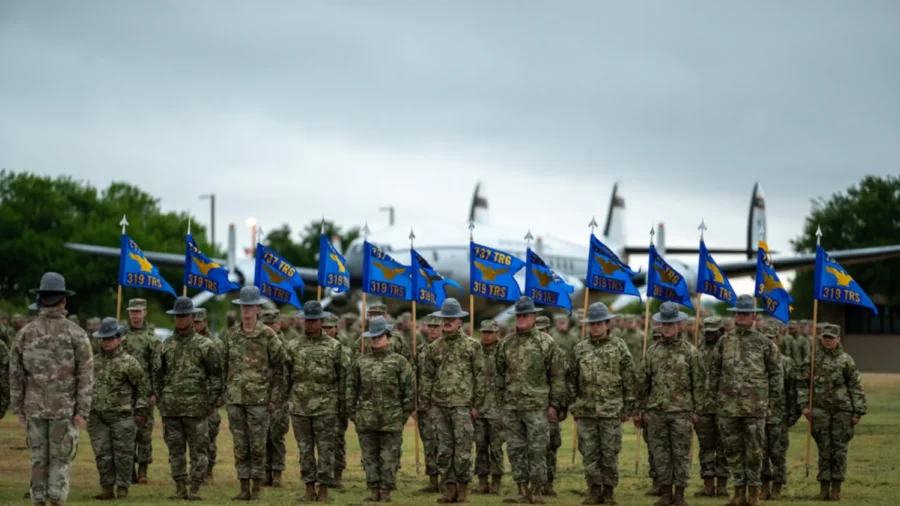The Department of the Air Force has raised its entry qualifications for officers and enlisted airmen, in a move that may help the services bolster recruitment after experiencing a recent shortfall.
In an Oct. 24 memo, the Department of the Air Force announced revised entry policies that state individuals seeking to commission must be between the age of 18 and 42 years, while those seeking to enlist must be at least 17 years old but not yet 42 years old. The new policy effectively raises the upper age limit to enter the U.S. Air Force and U.S. Space Force from 39 to 42 years old.
The revised entry rules come after the Air Force fell about 2,700 Airmen short of its fiscal year 2023 recruiting objective; a 10 percent miss on the fiscal year goal to recruit 26,877 new active duty personnel. This year’s shortfall marked the first time the Air Force has failed to meet its recruiting goal for the active service component since 1999.
“This opens the aperture to allow more Americans the opportunity to serve,” Air Force Recruiting Service spokesperson Leslie Brown told NTD News in an emailed statement.
With a retirement cutoff age of 62 years old, Ms. Brown noted individuals could feasibly enter the Air Force or Space Force at 42 years old and still serve a full 20-year military career and obtain full military retirement benefits.
With the change, the Department of the Air Force now supports one of the oldest enlistment cutoff ages in the U.S. military.
Last year, the U.S. Navy implemented a similar policy change, letting in new enlisted recruits so long as they can report for recruit training before they turn 42. The U.S. Army allows for new enlisted recruits up to 35 years old while the U.S. Marine Corps has a cutoff age of 28 years old.
The Department of the Air Force previously raised its maximum recruiting age in 2014, from 27 to 39 years old, thus allowing hundreds of new recruits in their 30s in the years since.
Ms. Brown said the Air Force could take in approximately 50 additional potential recruits each year as a result of this latest age limit change.
US Military Struggling to Attract New Recruits
Fiscal year 2023 marks the second in a row that the military has struggled to meet all of its recruiting objectives.
In fiscal year 2022, the Air Force met its active-duty recruiting goals but acknowledged missing its objectives for the Air Force Reserve and Air National Guard components.
The Navy also hit its recruiting goals for active-duty personnel last year but fell short when it came to recruiting new active and reserve officers and reserve enlisted personnel. The Navy reported falling short by 209 active-duty officers, 378 reserve officers, and 1,958 reserve enlisted personnel.
The Marine Corps was the only U.S. military branch to report meeting its recruiting goals for enlisted personnel and officers in both its active and reserve components in fiscal year 2022.
It was the Army, however, that saw the largest recruiting miss in the 2022 fiscal year. The service fell about 15,000 recruits short of the 60,000 active-duty recruit goal for fiscal year 2023, marking a 25 percent miss.
The Army again came up short in fiscal year 2023, bringing in 10,000 fewer active duty soldiers than it had set out for with its active duty component. The Navy also missed its fiscal year 2023 recruiting goal, bringing in 7,000 fewer active duty sailors than it had planned.
The various military branches have attributed their recruiting struggles to a declining interest and propensity for service, and falling eligibility rates among the prime recruiting-age demographic. A 2020 Department of Defense assessment concluded that about 77 percent of Americans between 17 and 24 years old would be ineligible to serve without some form of waiver. The assessment found that 11 percent of the 17–24-year-old population would be disqualified for weight reasons alone.
Some Republican lawmakers and even active-duty troops have put part of the blame for the military’s recruiting struggles on the perceived political slant of the military in recent years.
In November of last year, the Ronald Reagan Presidential Foundation published its National Defense Survey results (pdf) for 2022, finding just 48 percent of respondents had “a great deal” of trust and confidence in the military; a 22-point drop since 2018. In July, Gallup pollsters reported the lowest level of confidence in the U.S. military among the U.S. public in 26 years.

